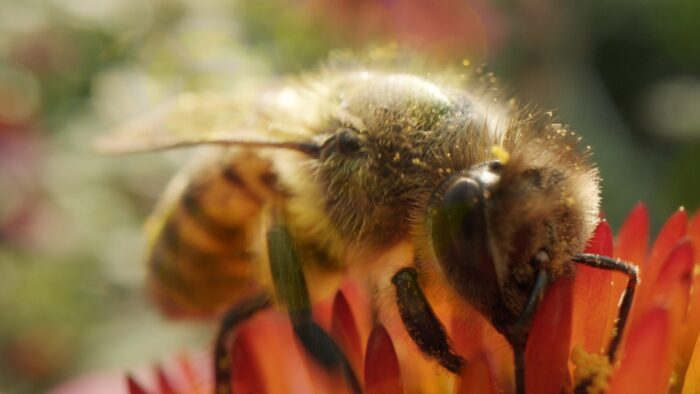Roundup is the most widely used weed killer in the world. The well-known brand name of the glyphosate-based herbicide developed and patented by Monsanto in the 1970s, Roundup became the company’s most successful product, accounting for about half of its yearly revenue, and it and other glysophate-based herbicides became, over the decades, commonplace in agricultural and general use across the globe over the past five decades; another 114 million pounds of the chemical are deployed in non-agricultural settings every year. The use of Roundup and herbicides like it let gardeners, farmers, and industries contain weeds and grow thriving crops and ground cover. Into the Weeds, a new environmental documentary directed by Jennifer Baichwal, charts the product’s growth and ubiquity as well as an even more pressing question: does Roundup cause cancer?
Ask Dewayne “Lee” Johnson.
Having long been unemployed, he was ecstatic to be hired as a groundskeeper for the Benicia Unified School District in California. “That job saved me from the bottom,” he says. His job was to spray the district’s facilities with Ranger Pro, the commercial-grade variant of Roundup: wearing a mask, protective gloves, and a Tyvek suit, he’d soak the district’s fields, fence lines, and hillsides with the herbicide. His safety trainer minimized any risks, telling him the product he applied was “safe enough to drink,” Johnson recalls.
One day, his hose snapped, and despite his protective gear, he got caught in a shower of Ranger Pro, soaking his suit. Not long after, he discovered a lesion on his leg; soon after, his entire body was covered. The diagnosis: Non-Hodgkin’s lymphoma.
Prior to his groundskeeping work, Johnson was an able-bodied, healthy man in his 40s, proud of his robust, athletic appearance. Now, his health has deteriorated. He speaks and moves with the measured cadence and slowed gait of the aged. His skin is blotted and mottled, flakes of it falling from his face and body. His limbs are covered in painful pustules. Bandages can barely cover his gaping wounds. These are the consequences, he alleges, of his continued contact with the Monsanto herbicide.
The science backed up his claim: in 2015, the International Agency for Research on Cancer (IARC), a branch of the World Health Organization, classified glyphosate as “probably carcinogenic to humans.”

Johnson’s would be the bellwether case in a mass tort against Monsanto—now Bayer, their having acquired Monsanto in 2018—and one that involved tens of thousands of plaintiffs whose lives were, like Johnson’s, upended by their diagnoses of Non-Hodgkin’s lymphoma. Into the Weeds follows Johnson and his lawyers though the labors of his trial against the powerful industry giant, and what it reveals is far more grotesque than any cancer. To defend itself against liability for Johnson’s and others’ illnesses, Monsanto stacked the deck. They’d been examining glysophate’s potential to cause cancer for decades, but influenced a handful of corrupt scientists to falsify studies, ghostwrite papers, and, in general, absolve themselves of any responsibility for the mass harm their product incurred.
It’s a sobering affair, but it’s a tale necessarily told. The “Monsanto Papers”-–the collection of the company’s internal documents evidencing their corporate malfeasance and the lengths they would go to protect their corporate freedom to operate—are presented here in chilling detail, with video of their perpetrators’ depositions trapping the faux scientists and public-relations flacks in obvious falsehoods. Baichwal’s documentary lays out both the details of the case in a taut, even suspenseful narrative, with occasional tangents to explicate the chemical’s use and ubiquity across the globe.

Those include its application in all kinds of nonagricultural uses: parks, golf courses, highways, railway lines, cemeteries, even swaths of forest. And its residue has been detected in a wide variety of food products. Whether or not the Johnson trial will rule in the plaintiff’s favor, Into the Weeds raises even more pressing questions. With farmers dependent upon ever-smaller profit margins, can they afford to abandon the use of an effective—albeit cancerous—product? How has or will glysophate’s application impact our our ecosystemic biodiversity? Can the case with its simple, dramatic origins eventually effect any kind of lasting change?

With music from renowned producer Daniel Lanois (Bob Dylan, Robbie Robertson, U2), cinematography by John Price, and a tight edit from Ronald Schimmle, Into the Weeds makes for an informative, elucidating David versus Goliath tale, one worth watching, pondering, and more importantly, acting upon. It’s not just Dewayne “Lee” Johnson’s health at stake. It’s thousands of others’. The entire world’s, even.
Into the Weeds is debuting theatrically in a national event on October 3, 2023, on more than 600 screens, with exclusive follow-up bonus footage exploring the question: “Can there be a future without pesticides and if so, how do we get there?” The event will feature findings and expert testimony from scientists, doctors, policymakers, farmers, environmentalists, food safety advocates, and concerned public figures.
Tickets for Into the Weeds can be purchased via FathomEvents.com and at participating theaters. For more information on the film, visit the official Into the Weeds site at https://www.intotheweedsimpact.com/.




